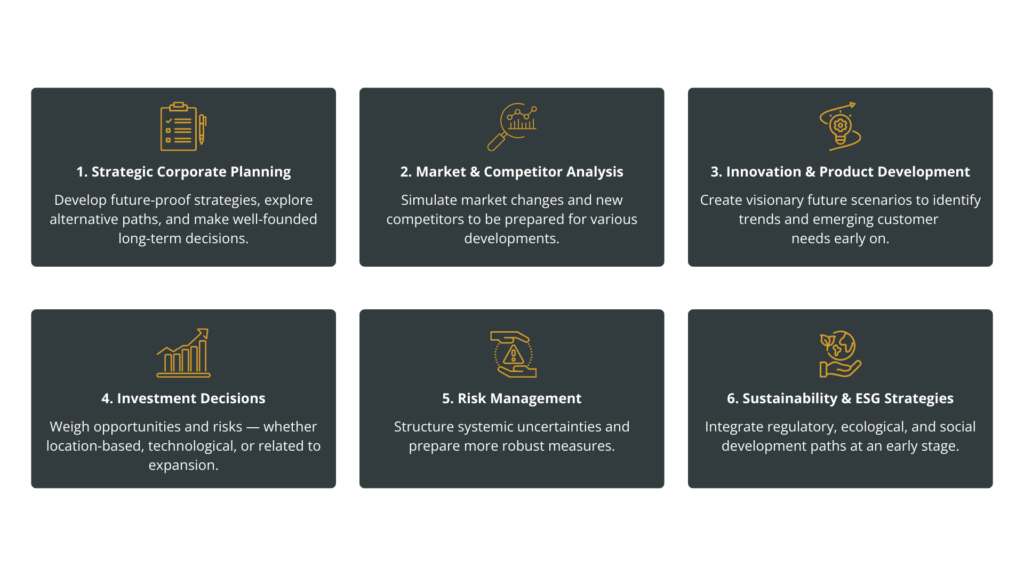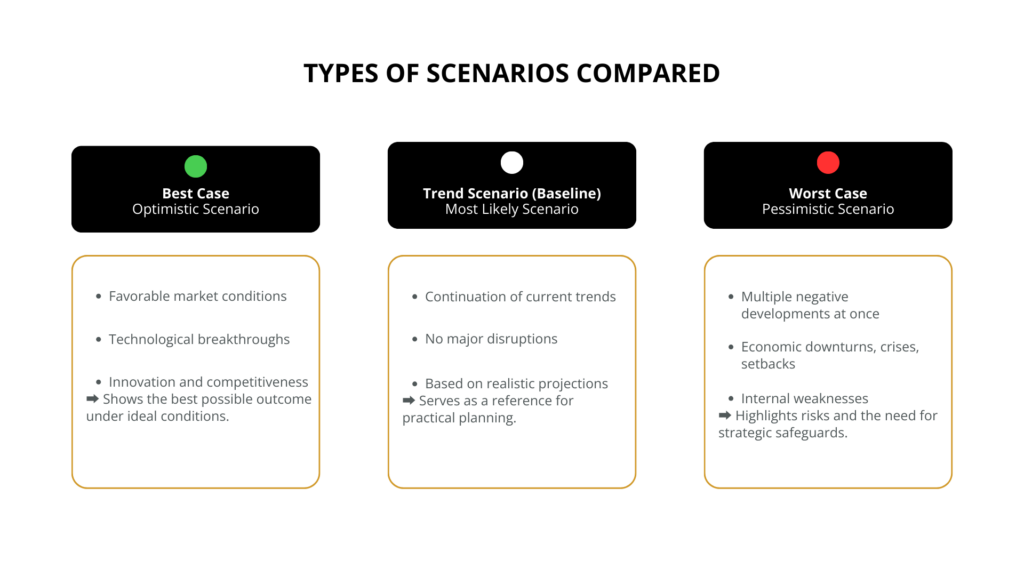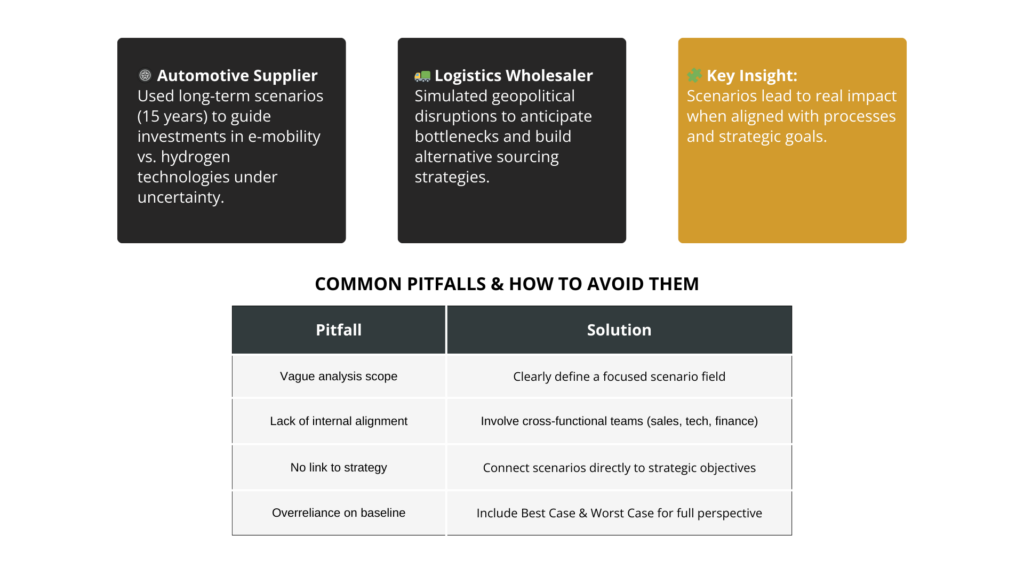
The most important facts in brief:
Scenario analysis is a proven method of strategic planning that companies use to systematically examine and evaluate possible future developments. The aim is to create a robust basis for decision-making by running through various future scenarios – from best-case to trend to worst-case. External and internal influencing factors, their interactions and potential consequences are analyzed. Scenario analysis is particularly suitable for supporting strategy development, for early clarification of uncertainties and as an instrument for preparing decisions in dynamic markets.
What is a scenario analysis? – Concept, definition and objectives
Scenario analysis is a qualitative analysis method that companies use to think through and evaluate possible future developments in a structured manner. The aim is to create future scenarios, taking into account various influencing factors, which serve as a basis for strategic planning decisions.
History and development
The origins of scenario analysis lie in military and security policy. In the 1950s, the American futurologist Herman Kahn developed the basic idea of systematically designing potential future scenarios at the RAND Corporation in order to better prepare political decisions. The method has been increasingly used in economics since the 1970s – especially in companies that have to adapt to uncertain, dynamic markets.
Differentiation from the scenario technique and related methods
The terms scenario analysis, scenario technique and scenarios are often used interchangeably. However, the specialist literature recommends a differentiated approach:
- Scenario analysis: Evaluation and interpretation of scenarios with regard to their consequences and strategic relevance.
- Scenario technique: Overarching method that covers the entire process – from defining objectives to development and implementation.
- Scenarios: Concrete characteristics of possible future developments; result of the analysis.
The aim of scenario analysis is to systematically structure uncertainties in order to make companies capable of taking action. It helps to make alternative development possibilities visible and thus to place strategic decisions on a sound, broadly supported basis. In addition, robust options for action and early indicators can be derived from the developed future scenarios in order to be able to react to changes in the corporate environment at an early stage.

Why companies should use scenario analyses
In an increasingly volatile and complex world, the ability to think through various development possibilities in advance is a strategic competitive advantage. Scenario analysis offers companies precisely this opportunity: it creates a structured understanding of possible futures and helps to actively manage uncertainties.
Benefits for strategy development and decision preparation
Scenarios are not predictions, but plausible alternatives that help companies to prepare for different future developments. The analysis of these scenarios is particularly useful for:
- the early identification of strategic risks and opportunities,
- the development of robust strategies,
- the preparation of decisions under uncertainty,
- the development of long-term strategic resilience.
By mentally “playing through” alternative visions of the future, core assumptions can be critically scrutinized and implicit thought models made visible – a decisive factor in preventing blind spots in planning.
Vereinbaren Sie mit uns einen kostenfreien Beratungstermin.
Beratungstermin vereinbarenTypical areas of application in the company
Scenario analysis can be used in a variety of strategic and operational contexts – especially where uncertainty, complexity or long-term effects play a role:
- Strategic corporate planning
For developing long-term objectives and strategic options in an uncertain market environment. Scenarios help to examine alternative paths and set a sound strategic course. - Market and competition analyses
To systematically record the effects of possible market changes, new competitors or regulatory developments and derive options for action. - Innovation and product development
As the basis for creative visions of the future that anticipate new customer needs, technological trends or disruptive business models. - Investment decisions
To assess potential opportunities and risks across different future developments – for example when choosing a location, expanding or investing in technology. - Risk management
In addition to traditional risk instruments, scenario analysis enables a more comprehensive understanding of uncertainties and systemic interactions. - Sustainability strategies and ESG scenarios
To incorporate various regulatory, environmental or social development paths into planning – from CO₂ pricing to social governance issues.
The ability to think and act with an eye to the future is critical to success, especially in today’s world, in which companies are confronted with multiple crises, disruptive technologies and dynamic market changes. Scenario analysis provides a proven, practical tool for this.

The scenario analysis process – phases and methodology
The implementation of a scenario analysis follows a structured, multi-stage procedure. It is crucial to ask the right questions, identify the relevant influencing factors and integrate the results into the planning process in a targeted manner. In the following, we present the typical phases of a scenario analysis – supplemented by a compact overview in table form.
Step 1: Definition of the question and the scenario field
It starts with a clear definition of the problem: Which topic should be considered? Is it a new market strategy, investment decision or product development? It is equally important to define the scenario field, i.e. the area of analysis – e.g. “future of mobility” or “development of the energy market”.
A precisely formulated object of investigation is the prerequisite for ensuring that the analysis remains controllable and target-oriented.
Step 2: Analysis of influencing factors and framework conditions
In this phase, all relevant influencing factors are recorded and their interactions evaluated. These include:
- Social, economic, political and technological factors
- company-internal variables such as innovative strength, cost structure, resources
- External influencing factors such as customer behavior, market trends or legal framework conditions
Methods such as PEST analysis, the Delphi method or expert interviews help to structure the information.
Vereinbaren Sie mit uns einen kostenfreien Beratungstermin.
Beratungstermin vereinbarenStep 3: Development of possible visions for the future
Coherent scenarios are created based on the identified factors – typically a best case, a trend scenario and a worst case. Each variant represents a consistent picture of the future based on a combination of different influencing factors.
Important: It’s not about probabilities, but about plausibility and relevance. Scenarios should challenge, not reassure.
Step 4: Derivation of recommendations for action
Finally, the scenarios are transferred to the business context. In other words: What strategic options arise?
Which risks are realistic? Which leading indicators should be monitored?
This phase provides concrete recommendations for action and shows how strategies can be flexibly adapted to different future developments.
Types of scenarios: Best case, trend and worst case in comparison
A central element of any scenario analysis is the development of several alternative scenarios that differ significantly from one another in terms of their assumed developments. A distinction is usually made between three basic types of scenarios that represent different futures – from the optimal to the most critical case.
Characteristics of the scenario types
Best case
The optimistic scenario: Here, the business environment develops particularly favorably. Technological breakthroughs, market opportunities or political framework conditions promote growth, innovation and competitiveness. This scenario shows how the company could ideally benefit – assuming that all positive influencing factors coincide.
Trend scenario (baseline)
The most likely scenario, also known as the trend scenario: It is based on the extrapolation of current developments and assumptions. No radical changes are assumed here, but rather a continuation of existing trends – for example with regard to market behavior, customer needs or regulatory framework conditions. It serves as a reference point and provides a realistic basis for planning.
Worst case
The pessimistic scenario: negative developments occur simultaneously – such as economic downturns, geopolitical crises, technological setbacks or internal weaknesses. This scenario shows which risks the company should take seriously and where strategic hedging is necessary.
When which scenario type makes sense
The development of several scenario types allows strategic options to be tested for robustness.
The following applies:
- Best case: promotes ambitious goals and innovative thinking
- Trend scenario: serves as a basis for realistic action planning
- Worst case: enables risk assessment and hedging
In dynamic markets in particular, however, companies should not just follow the trend scenario – they should also actively check how flexible their strategies are in the face of positive or negative deviations.

Practical examples and typical errors in application
Scenario analysis is an effective method – provided it is used in a targeted and methodical manner. Many companies today use it successfully as part of their strategic planning. In practice, however, there are also typical weaknesses that can limit the benefits.
Successful implementation in business practice
A leading automotive supplier used various future scenarios as part of its scenario technology in order to secure its investment decisions in new drive technologies. Scenarios with a time horizon of 15 years were developed in order to take into account both political and technological uncertainties (e.g. e-mobility vs. hydrogen).
Another example comes from the field of logistics planning: a wholesaler used scenarios to simulate the effects of geopolitical disruptions on its supply chains. The analysis helped to identify critical bottlenecks at an early stage and establish alternative sources of supply.
Such practice-oriented applications show that scenarios are not just abstract models, but can provide concrete impulses for action – especially when they are compared with the company’s operational processes and actual situation.
Common pitfalls and how to avoid them
In practice, similar errors occur again and again:
- Insufficient description of the scenario field: If the field of analysis is chosen too broadly or too vaguely, the results remain arbitrary and do not guide action.
- Lack of internal coordination: Without interdisciplinary participation, important perspectives are left out – for example from sales, technology or finance.
- Neglecting the strategic reference: Scenarios must be linked to the corporate strategy, otherwise they lose their relevance for decisions.
- Fixation on the trend scenario: If only a supposedly “realistic” course is considered, risks and opportunities are often not taken into account.
Successful scenario work means consistently combining the technique of analysis, the reality of the company and the strategic target image.

Scenario analysis as a strategic tool with a future
Volatile markets, technological disruptions and geopolitical tensions demand a high degree of adaptability from companies. In this context, scenario analysis is becoming increasingly strategically important. It is far more than just a methodical tool – it enables companies to deal with possible future developments in a structured manner and derive well-founded, reliable decisions from them.
The ability to methodically think through different development paths creates clarity in uncertain situations and strengthens entrepreneurial resilience. The aim is not to predict, but to prepare for different scenarios in order to be able to react strategically and flexibly.
Scenario analysis is particularly effective when it is integrated into existing planning and control processes – supported by modern data and analysis technologies. This makes it a central component of future-oriented corporate management.
| No. | Phase | Objective |
|---|---|---|
| 1 | Definition of the research question | Clear research framework, focus on relevant questions |
| 2 | Analysis of influencing factors | Recording and evaluation of relevant internal and external factors |
| 3 | Development of scenarios | Development of plausible, consistent future scenarios (e.g. best case, trend, worst case) |
| 4 | Derivation of measures | Transfer of the scenarios into concrete strategic recommendations for action |
Frequently asked questions about scenario analysis
1 What is the difference between scenario analysis and scenario technique?
The scenario technique encompasses the entire methodical process of developing, analyzing and implementing scenarios. Scenario analysis is one part of this – it focuses on evaluating the scenarios developed in terms of their consequences and their strategic relevance for the company.
2. in which areas of a company is scenario analysis particularly helpful?
Scenario analyses are used in many areas – for example in strategy development, risk management, product development and investment decisions. It is particularly helpful where long-term planning is associated with a high degree of uncertainty.
3. how long should the time horizon of a scenario analysis be?
The appropriate time horizon depends on the respective application. For technological developments or social changes, periods of 10 to 20 years often make sense. In operational planning, 3 to 5 years are often sufficient. The decisive factor is that the time period offers enough room for different developments.
4 What role does technology play in the implementation?
The selection of suitable techniques and tools is key to the efficiency and informative value of the analysis. In addition to traditional methods such as influencing factor analysis or the morphological box, digital analysis platforms, data visualization and simulation tools are also used today – for example to depict complex scenario clusters.
5. does the scenario analysis have to be based on an exact actual situation?
Yes, a well-founded scenario analysis always begins with a precise description of the current situation. Scenarios can only be developed and evaluated in a meaningful way if the current starting position – including all relevant internal and external influencing factors – is correctly recorded.







